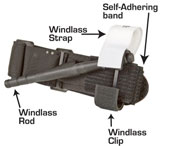

The Combat Application Tourniquet Dr. Brad Bennett provided an excellent workshop at the 2010??Wilderness Medical Society annual meeting in Snowmass, Colorado on how to??manage severe bleeding, based on his work with the Committee on Tactical Combat??Casualty Care. From time to time,
wilderness medicine practitioners encounter situations of severe bleeding, so??this information is essential for anyone responsible for the health and safety??of outdoor explorers and adventurers.
In a simple algorithm, we learned that the first attempt to??control bleeding is almost always direct hand pressure. This is followed by??application of a pressure bandage. If that is successful, the victim then is??evacuated. If the pressure bandage does not adequately control bleeding on the??torso of the victim, then a hemostatic (stops bleeding) substance is applied??prior to evacuation. If bleeding from an arm or leg threatens the victima??s??life, a tourniquet may be required. A hemostatic agent that is being used with??increasing frequency is QuikClot Combat Gauze. Tourniquets include the Combat
Application Tourniquet (a??C-A-Ta??). Using any of these modalities requires??instruction and preparation.
QuikClot is composed of microporous,??aluminosilicate minerals (zeolite), and does not release heat when applied to the??site of bleeding. It can be integrated into woven kaolin-impregnated gauze. The??kaolin causes rapid blood clotting where the gauze is applied and is not??absorbed into the body. The gauze is safe to leave in the wound until further??medical care becomes available. To use the gauze, one opens clothing around the
wound, and then if possible, removes excess pooled blood from the wound while??preserving any blood clots that have already been formed in the wound. The most??active source of bleeding should be located and the gauze packed tightly in to??the wound directly on the source of bleeding. It may be necessary to use more
than one gauze roll. It is very important to remember that after the gauze is??packed into the wound, pressure directly over the bleeding must still be??applied continuously for a minimum of three minutes or until the bleeding??stops. The packed portion of the gauze is then anchored in place by wrapping??and tying the remainder of the bandage, or using another bandage, to maintain??pressure.?? If the bleeding continues to
briskly soak through the gauze, then the wound may be repacked with the??original gauze (or new gauze if available) to more accurately apply pressure.
A tourniquet is used on an arm or leg to stop bleeding from??a survivable wound. The Combat Application Tourniquet (C-A-T) is a small and??lightweight one-handed (i.e., the victim can self-apply the tourniquet)
tourniquet that completely occludes arterial blood flow in a limb. To apply??this tourniquet, it is ideally placed on the bare arm or leg a few inches above??the site of bleeding (between the bleeding and the heart). Next, one pulls the??self-adhering band to tightness and securely fastens it back on itself.?? Then, the windlass rod is twisted until??bleeding has stopped. The windlass rod is then locked in place with the??windlass clip. Then, the self-adhering band is adhered over the windlass??rod.?? To complete the process, everything
is secured by grasping the windlass strap and pulling it tightly and then fastening??it to the opposite hook on the windlass clip. Obviously, it is important to??practice with the device prior to attempting to use it in a critical??life-threatening situation.
There are a few tips for tourniquet users. One may need a??second tourniquet between the first tourniquet and the heart if bleeding is not??controlled with the first tourniquet. One should not place a tourniquet
directly over a knee or elbow, because it may not be effective. One should not??place a tourniquet directly over a pocket that contains bulky items. Tighten??the tourniquet enough to eliminate any arterial pulsation beyond the??tourniquet. Whenever a tourniquet is used, it is important to expose and??clearly mark all tourniquet sites with the time of tourniquet application with??an indelible market. This is important because it will help medical personnel??understand the situation with the treated limb and perhaps estimate the chance??of survival for tissue that has been deprived of blood flow. If a tourniquet is??applied, understand that loosening it periodically to allow circulation to??return to the limb might well cause unacceptable additional blood loss, so??should not be done. Do not loosen or remove the tourniquet if the victim will
arrive at a medical treatment facility within two hours after time of??application, if it has been in place for more than six hours, or if the limb??beyond the tourniquet has been amputated. If one decides to loosen or remove a??tourniquet because the bleeding is felt to be controlled, then it must be??loosened slowly while observing for bleeding. Preferably, one is immediately??able to apply a hemostatic bandage (described above) to the wound under a??pressure dressing. The tourniquet is left loosely in place in case it needs to
be re-tightened.
This post, How To Stop Bleeding: The Combat Application Tourniquet And QuikClot, was originally published on
Healthine.com by Paul Auerbach, M.D..
No comments:
Post a Comment